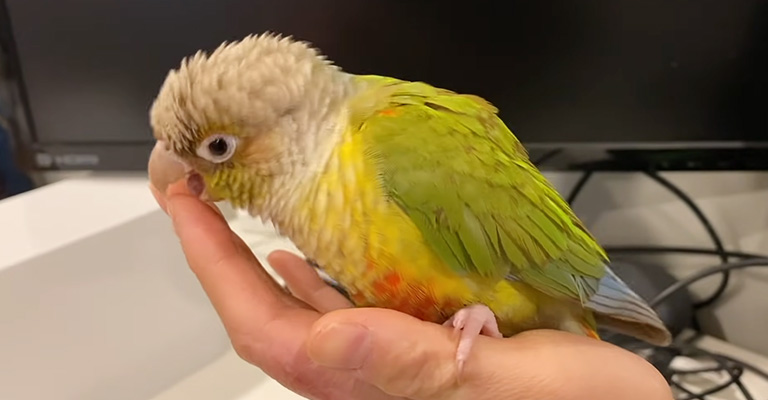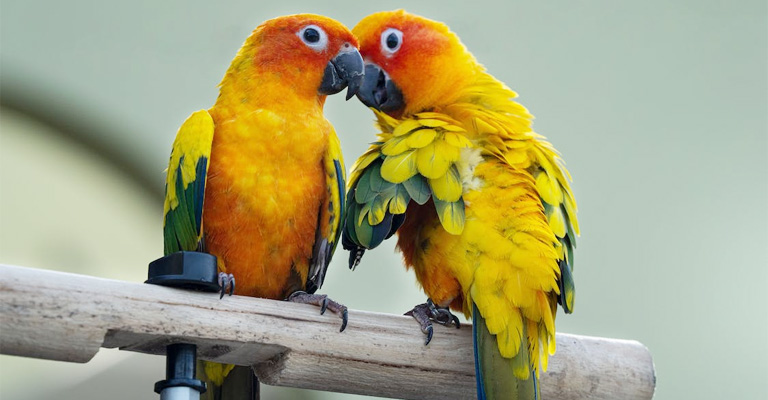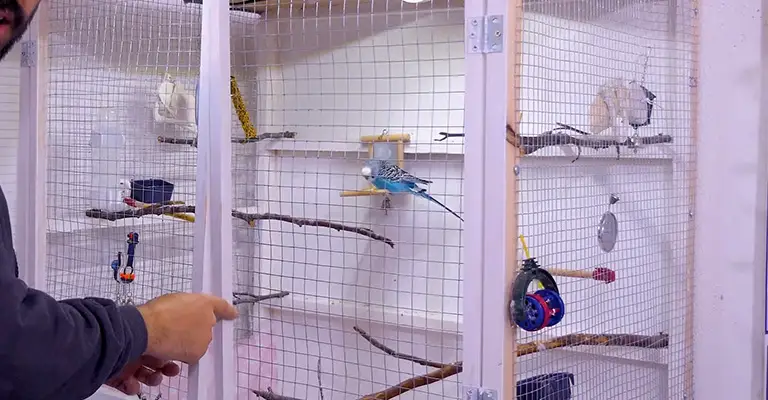The intriguing dynamics of avian companionship can sometimes present unexpected challenges, leaving pet owners pondering perplexing behaviors such as, “Why does my conure keep biting and pulling on the budgie’s feathers?”
This puzzling behavior, while concerning, often stems from a combination of natural instincts, social dynamics, and individual personalities among birds.
The interaction between a conure and a budgie within a shared living space can lead to fascinating yet complex behavioral interactions, shedding light on their social hierarchy, communication methods, and even potential stressors.
In this exploration, we delve into the various reasons behind this behavior, encompassing factors like dominance tendencies, attention-seeking, and even potential health concerns.
By understanding the underlying motivations that drive conures to bite and pull on budgie feathers, we can employ effective strategies to address and manage this behavior, ensuring the well-being and harmony of our feathered companions.

Why Does My Conure Keep Biting And Pulling On The Budgie’s Feathers?
It’s not uncommon for conures to exhibit behaviors like biting and pulling on other birds’ feathers, such as budgies.
However, understanding the reasons behind this behavior is essential for maintaining a harmonious avian household.
Here are some potential reasons for this behavior:
Exploratory Behavior
Conures are naturally curious birds, and they may engage in feather-pulling as a form of exploration.
They use their beaks to examine textures and surfaces, which can inadvertently lead to pulling on other birds’ feathers.
Attention Seeking
Conures may pull on feathers to gain attention, especially if they notice that their actions elicit reactions from budgies or humans.
Negative attention can inadvertently reinforce this behavior.
Dominance or Territory
Feather pulling might be an expression of dominance or territorial behavior. Conures may view the budgie as a potential rival or intruder in their space.
Boredom
Birds, including conures, can display feather-destructive behaviors when bored. Feather pulling could be an outlet for their excess energy or a way to alleviate boredom.
Social Interaction
Feather pulling can be a way of initiating social interaction. Conures might be attempting to engage the budgie in play or interaction, even though the budgie may not appreciate the attention.
Mate-Like Bond
If the conure and budgie have formed a close bond, the conure might exhibit behaviors that are reminiscent of preening that would occur between mates. However, this can sometimes escalate into excessive feather pulling.
Stress or Anxiety
Stressors in the environment, such as changes in routine, new additions to the household, or lack of mental stimulation, can lead to feather pulling as a manifestation of stress or anxiety.
Molting Imitation
During molting, birds naturally lose feathers. Conures might see the budgie molting and mimic the behavior, resulting in feather pulling.
Health Issues
Feather pulling can also be a sign of health problems, such as skin irritations, infections, or discomfort. It’s crucial to rule out any underlying medical conditions by consulting an avian veterinarian.
In all cases, it’s essential to address the behavior promptly to prevent harm to the budgie and maintain a positive environment. Provide ample enrichment, mental stimulation, and social interaction for both the conure and budgie.
If the behavior persists or escalates, consulting an avian behaviorist or veterinarian can offer tailored solutions to manage and mitigate the feather-pulling behavior.
How Do I Train My Conure To Stop Biting The Budgie’s Feathers?

Training a conure to stop biting the budgie’s feathers requires patience, consistency, and a well-thought-out approach that focuses on positive reinforcement and redirection.
Here are some training tips to help you address this behavior:
Positive Reinforcement
Reward your conure with treats, praise, or a soothing voice whenever it engages in positive behavior around the budgie.
This reinforces the idea that good behavior leads to positive outcomes.
Separation and Supervision
During the initial stages of training, separate the conure and budgie while you’re not around to supervise. This prevents the opportunity for unwanted interactions and reinforces positive behavior when you’re present.
Redirection
When you notice the conure attempting to bite the budgie’s feathers, gently redirect its attention to a preferred toy, perch, or activity. Offer positive reinforcement when the conure engages in the redirected behavior.
Desensitization
Gradually expose the conure to the budgie without direct contact. Place their cages near each other, allowing them to get used to each other’s presence without the possibility of negative interactions.
Gradual Introduction
Over time, introduce the conure and budgie in a controlled environment. Start with short supervised interactions, gradually increasing the duration as they become more accustomed to each other.
Time-Outs
If the conure persists in attempting to bite the budgie, use a time-out approach. Remove the conure from the environment for a brief period to emphasize that the undesirable behavior leads to a loss of interaction.
Consistency
Consistency is key in training. Ensure that all family members follow the same training approach, and be patient as behavior change takes time. Celebrate small victories and remain committed to reinforcing positive interactions.
Remember that the process may take time, and the conure’s behavior won’t change overnight. Building a positive relationship between the conure and budgie requires careful guidance, respect for their individual personalities, and a commitment to their well-being.
If you encounter challenges or need personalized guidance, consider consulting with an avian behaviorist who can offer tailored strategies for your specific situation.
What Would It Cause If I Kept A Budgie Permanently In A Cage?

Keeping a budgie permanently in a cage can cause many health problems for your bird. Some of the possible symptoms are:
Obesity And Diabetes
If your budgie does not get enough exercise and movement, it can gain excess weight and fat, which can affect its metabolism and insulin production.
This can lead to obesity and diabetes, which can cause various complications, such as heart disease, liver disease, or respiratory issues.
Muscle Atrophy And Cardiovascular Problems
If your budgie does not use its muscles and wings regularly, it can lose its muscle mass and strength, which can affect its mobility and balance.
This can also reduce blood circulation and oxygen delivery, which can affect heart and lung function.
Respiratory Infections And Feather Plucking
If your budgie is exposed to poor ventilation, hygiene, or lighting in its cage, it can inhale dust, dirt, or mold, which can irritate its respiratory system and cause infections or inflammation.
It can also damage its feathers and skin, which can cause it to pluck or chew on its feathers to relieve the discomfort.
Eye Problems And Vitamin D Deficiency
If your budgie does not get enough natural sunlight in its cage, it can affect its vision and eye health.
It can also affect its vitamin D synthesis and calcium metabolism, which are essential for its bone and feather growth and development.
Boredom, Frustration, Or Depression
If your budgie does not get enough mental stimulation and enrichment in its cage, it can feel bored, frustrated, or depressed. It can lose its interest in food, water, or toys and become inactive or lethargic.
It can also develop behavioral problems, such as aggression, screaming, or self-mutilation.
Loneliness, Anxiety, Or Fear
If your budgie is isolated from other birds or humans in its cage, it can feel lonely, anxious, or fearful.
It can become more timid or shy and avoid any contact or interaction with you or other birds. It can also become more stressed or nervous and show signs of panic or distress.
Impaired Cognitive And Learning Abilities
If your budgie does not get enough socialization and interaction in its cage, it can affect its cognitive and learning abilities.
It can have trouble remembering, solving problems, or communicating with you or other birds. It can also have difficulty bonding or cooperating with you or other birds.
FAQ
Conures might bite and pull on budgie feathers due to instincts like exploration, dominance, or social interaction.
It could also stem from boredom, attention-seeking, or even health issues. Understanding the underlying reasons helps address the behavior effectively.
Feather pulling is not considered a normal or desirable behavior between species. It can be a sign of various underlying factors, including dominance, stress, or a need for attention.
Early intervention and appropriate training are crucial to curb this behavior.
To discourage biting, employ positive reinforcement by rewarding good behavior and redirecting the conure’s attention to toys or treats.
Gradual introductions, supervised interactions, and consistent training can help replace undesirable behavior with positive interactions.
Yes, health problems could contribute to feather-pulling behavior. It’s advisable to rule out any underlying medical issues through a visit to an avian veterinarian.
Discomfort, skin irritations, or infections might lead to stress-related behaviors like feather pulling.
Yes, training can play a vital role in curbing feather-pulling behavior.
Strategies such as positive reinforcement, redirection, gradual introductions, and consistent training can help modify behavior patterns, improve social dynamics, and foster a healthier environment between conures and budgies.
Conclusion
As avian enthusiasts, decoding the intricate behaviors of our feathered friends remains an ongoing endeavor.
The question of why a conure engages in feather-biting and pulling on a budgie’s feathers showcases the nuanced interplay of social dynamics, instincts, and unique personalities within the avian realm.
While it can be a perplexing challenge, the insights gained through this exploration empower us to respond effectively.
By employing techniques such as positive reinforcement, gradual introductions, and understanding the nuances of bird behavior, we can guide our conures and budgies towards harmonious interactions.
Ultimately, it’s a testament to the depth of our commitment that we continually seek to comprehend and nurture the bonds that unite our avian companions, fostering an environment where both their individuality and shared connections thrive.